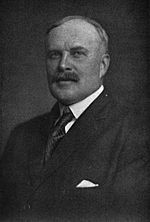George Junior Republic facts for kids
The William George Agency for Children's Services (formerly the George Junior Republic) is a non-profit residential treatment center for adolescent boys and girls located in Freeville, New York, United States.
History
William Reuben George founded a junior republic within the Republic of the United States whose economic, civic, and social conditions, reproduced those of the United States, and whose citizenship is vested in young people, especially those who were neglected or wayward.
George (born 1866) was a native of West Dryden, near Freeville, who as a businessman in New York City became interested in the urchins of the street and their gangs and began to organize them into more productive groups who helped, rather than hindered the police. He longed to give these "toughs" some of the summer fresh air and fun he had experienced as a child on the family farm.
In the summer of 1890, he took 22 children to Freeville with funds received from the New York Tribune, the sponsors of The Fresh Air Fund charity. Each summer from then until 1895 the number of children increased. Over these early years, he slowly developed his idea of "nothing without labor" and of a Junior Republic with laws made by young "citizens" and an economic system controlled by youngsters.
In 1895, George and five volunteers stayed through the winter in Freeville and thus a permanent colony was founded.
There were Woman's Aid societies in New York City, Ithaca, Syracuse, Buffalo, Boston and elsewhere, to promote the work of the Republic. A republic for younger boys, begun at Freeville, was established in Litchfield, Connecticut; and a National Junior Republic near Annapolis Junction, Maryland, and a Carter Junior Republic at Readington, near Easton, Pennsylvania, are modelled on the George Junior Republic. In 1908–1910 new states were established at Chino, California, Grove City, Pennsylvania, and Flemington Junction, New Jersey. In February 1908 the National Association of Junior Republics was formed with Mr. George (its founder) as its director, its aims being to establish at least one republic in each state of the Union, and in other countries similar institutions for youth and miniature governments modelled on that of the country in which each state is established, and to establish colonies for younger children, to be sent at the age of fifteen to the Junior Republic.
Over the years of William George's leadership, he was supported and the Junior Republic was visited by many prominent people who were interested in learning from George's experiment. These included Lord Baden Powell, Eleanor and Franklin Roosevelt, Theodore Roosevelt, Thomas Mott Osborne, Alexander Forbes, Monsignor John Patrick Carroll-Abbing, and Jacob Riis to name a few.
Many of the early citizens of the Junior Republic went on to important careers and accomplishments. A supreme court justice, a Pulitzer Prize winner, an Academy Award recipient, a California state legislator, a French Croix de Guerre honoree, a missionary to China, and many who gave their lives in World War I and World War II.
Current activity
In 2005 the George Junior Republic changed its name to The William George Agency for Children’s Services, Inc.
Today’s residential programs preserve the Junior Republic’s ideals of general fitness, social development and well-roundedness, in which responsibility is treated more as an opportunity than a burden – while providing more focused clinical oversight and treatment, and a strong educational emphasis.
Although the agency has seen many programmatic changes over the years as the needs of children have evolved, one thing has never changed, namely the enduring efforts of caring adults working to improve the lives of disadvantaged, troubled youth. Expansion in the service of providing additional treatment opportunities to children in need has been an agency priority since the early 1990s. The agency's Board of Directors in concert with the senior leadership team have, for the last 20 years, made a concerted effort to serve high risk, high need populations who have historically been underserved in New York State. This expansion has taken the form of nine newly constructed, state of the art, residential homes, and many new and innovative programs.
The fall of 2005 marked the opening of a dually diagnosed program for youngsters with both intellectual disabilities and serious emotional, psychiatric disturbance. Previously, many of these youngsters were mixed in with youngsters with normal cognitive functioning, and were often exploited or isolated. The dually diagnosed program offers many specialized services and supports designed to improve their adaptive daily living skills, as well as their capacity to function independently. Currently there are 27 dually diagnosed beds.
Finally, in December, 2011, the girl’s program opened at Lodge Cottage. The agency had not served adolescent females in almost twenty years. In response to overwhelming and persistent consumer demand, the agency made the decision to serve girls with a history of trauma and abuse. In the nearly three years of operation, the program has been highly utilized and continues to be in great demand.
During the twenty-year period between 1994 and 2014, the agency has grown fourfold from approximately 45 beds to the present licensed capacity of 189 beds as part of their on-going commitment to serve at-risk youth in New York State.



